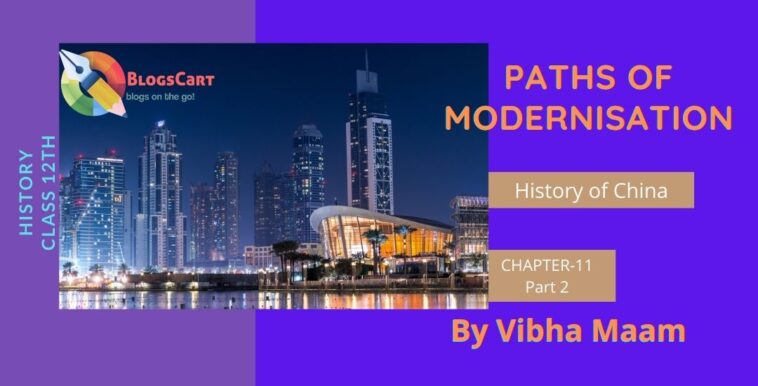Checkout handpicked notes of NCERT class 11th History Chapter 11 Paths of Modernization part 2 (History of China) notes by Vibha Madam, and share it with your friends and classmates.
Paths of Modernization notes by Vibha Maam
Geographical features of China
- Many climatic zone
- Three major river systems
- Yellow river (Huang He)
- Yangtze river (chang- jiang)
- Pearl river
- Large part mountainous region
- Ethnic group– Han
- Language -Putonghua(Chinese)
- Other nationalities– Uighur, Hui, Manchu, Tibetan
- Dialects-cantonese(Yue) Shanghainese(Wu)
- Food
- In south- cantonese cuisine (dim sum, pastries, dumplings)
- In north- Wheat(Szechuan spices, chillies (brought by Buddhist monk and Portuguese), fiery cuisine
- In east- rice and wheat
China
Three things China wanted to reform
- Regain sovereignty
- End of foreign occupation
- Equality and development
Three groups were there with their ideologies
- First group– reforms like Kang youwei, Liang Qichao used traditional ideas
- Second group -Republican revolutionaries such as Sun-yat- sue, (the first president of the Republic) used Japanese and western ideas
- The third group– Communist Party of China (CCP) wanted to end inequalities and weed out the foreigners.
First encounter of China with the West, when Jesuit missionaries introduced science and mathematics in the 16th and 17th century.
Second invasion in 19 century when Britain used force to expand profitable trade of opium( the first opium war, 1839-42)
Triangular trade of opium
- High demand for Chinese goods like tea, silk, porcelain by the British and the British had to pay into silver .
- To balance this trade problem and make it profitable, EIC grew opium in India and sold it in China and earned silver.
- They used these silver to buy tea, silk and porcelain. India was a colony of the British at that time and a big market for its finished goods.
The policies adopted by china against colonization
- Qing reformers such as Kang Youwei and Liang Qichao built a modern administrative system, a new army, an education system, and established a constitutional government to protect China from colonization.
- Confucianism (religion, introduced by Confucius) created a barrier to adopt new ideas and institutions.
- Students were sent to Japan, Britain, France to bring new ideas. They were became leading republicans
- In 1905, the old Chinese examination system was abolished. It was totally based on tradition.
Establishing the Republic
- Manchu Empire overthrown
- Republic established in 1911
- Sun-yat-sen, the founder of the modern China. He had Three principles (San min chui):-
a) Overthrown the foreign Empire like Manchu, Qing empire
b) Established democracy
c) Socialism
- 4th May 1919, post-war peace treaty signed between Japan and Britain, China was an Ally of Britain in war but China was ignored by Britain. A demonstration was held in Beijing against this insult.
Republican revolution instability in China
- Revolutionaries wanted reforms in China.
- Simple language in writing
- Abolished foot-binding
- Throw out the foreigners
- Remove inequalities
- Reduce poverty
- Equality in marriage
Guomindang (NPP- the National people’s party) and the CPP (Communist Party of China) were striving to unite the country. Political philosophy of the Guomindang
- Clothing
- Food
- Housing
- and Transportation
After the death of sun, Chiang Kai- Shek became the leader of Guomindang (NPP)
- He was influenced by the Confucius ideology.
- He controlled over Warlords
- Eliminated the communist
- Militarized the nation
- Encourage four virtues for women :-chastity ,appearance, speech and household work
- Low wages
- Poor working condition and long hours
- Petty condition of workers and women
The Guomindang popularity failed due to its narrow social base and limited political vision.
The rise of the Communist Party of China
- Japan invaded China in 1937
- Long and exhausting war weakened the China
- Prices rose 30% per month between 1945 and 1949
- Ordinary people had miserable life
Two Crisis occurred in china-
a) Ecological – Soil exhaustion, deforestation, floods
b) Socio-economic – Exploitative land tenure system, indebtedness, primitive technology, poor communication
- CCP founded in 1921, influenced by Russian revolution
- Mao Zedong was CCP leader worked for peasantry
- His success made CCP a powerful political power against the NPP
- Mao Zedong organised a strong peasants council (Soviet). His ideology was:
a) Independent government
b) Army
c) Redistribution of land
d) Rural women’s association
e) New marriage law
f) Simplified divorce
- The long March from Jiangxi to Shaanxi about 6000 miles
- The end of warlordism, land reform, weed out the foreigner imperialism program, carried out at a new base by Mao Zedong to create a strong social base.
Establishing the new Democracy 1949-65
Establishment of the new government ‘the People’s Republic of China’ in 1949. Principles of new democracy
- Alliance of all social classes
- Dictatorship of the proletariat
For socialist transformation
- The great leap forward movement launched in 1958 to rapid industrialization.
- Steel furnaces was set up in backyards
- In rural areas, people’s communes (collective farms) were started
- Creating a ‘socialist man’ who would have five loves -father, land ,people, labour ,science and public property.
Conflicting visions 1965-78
- Many critics are there in the Mao government.
- The Steel, produced in the backyard furnaces was not good for industry.
- Concept of ‘Socialist man’ was only an ideology rather than expertise
In fear of transformation of government
- Mao launched ‘the Great proletarian cultural revolution’ in 1965 to counter his critics.
- The Red Guards (students and army) were sent to the countryside to follow the communist ideology.
- The cultural revolution weakened the party and disrupted the economy and educational system.
Reforms from 1978
- The cultural revolution was led by Deng Xiaoping in 1978.
- Goal of the party ‘the four modernization’ (agriculture, industry, defense, and science)
- A wall-poster “the fifth modernization” criticized the CCP, proclaimed that without democracy modernization wouldn’t be possible.
- These demands were suppressed, students and demonstrators were brutally repressed at Tiananmen square (Beijing).
- Finally, ‘Traditional ideas’ and Confucianism are revived in China.
The Story of Taiwan
- After being defeated by CCP, Chaing- Shek fled to Taiwan 1949 with over US$300 million in gold reserves and art treasures and established the Republic of China.
- Taiwan was part of Japan after 1894-95.
- ‘The Cairo Declaration (1943)’ and the ‘Potsdam proclamation (1949)’ restored sovereignty to China.
- GMD (Guomindang NPP), established a repressive government.
- They imposed some restrictions, like forbidden free speech, political opposition, and exclusion of local people from high positions.
- They worked for land reforms, and moderzised the economy.
- GNP increased to 2nd position in Asia by 1973 after Japan. The economy is largely dependent on trade.
- However Taiwan transformed into a democracy after the death of Chiang (1975), martial law was lifted in 1987, opposition parties were legally permitted.
Don’t forget to comment in the comment section below to appreciate the hard work of our author by sharing this notes with your known person you can also Contact us for any query or if you are interested in writing with us.
Stay tuned for more amazing stories, poems & articles like this.
Click here to read first part of this chapter.
Use Canva for amazing images.











fabulous notes mam
Mam when will you upload part 3 of notes of ch path to modernization
Wow thanks mam😍
[…] here to read first part of this chapter & click here to read second […]